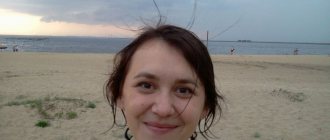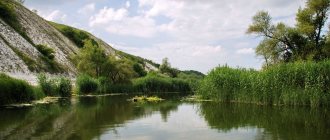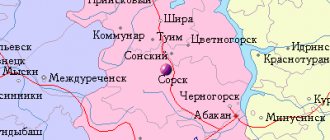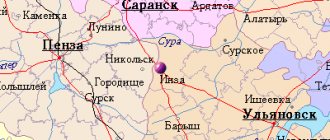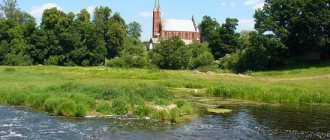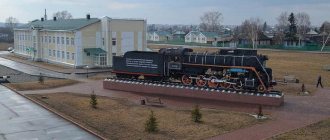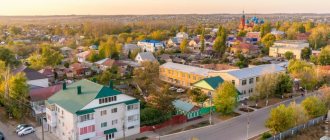City in Ryazan region, Russia
| Novomichurinsk Novomichurinsk | |
| Town[1] | |
| Street in Novomichurinsk | |
| Flag Coat of arms | |
| Location of Novomichurinsk | |
| Novomichurinsk Location of Novomichurinsk Show map of Russia Novomichurinsk Novomichurinsk (Ryazan region) Show map of Ryazan region | |
| Coordinates: 54°03′N 39°43'E / 54.050°N Latitude 39.717°E / 54.050; 39.717Coordinates: 54°03′N 39°43'E / 54.050°N Latitude 39.717°E / 54.050; 39.717 | |
| A country | Russia |
| Federal subject | Ryazan region[1] |
| Administrative region | Pronsky district[1] |
| City of district significance | Novomichurinsk[1] |
| Based | 1968 |
| City status from | 1981 |
| Height | 120 m (390 ft) |
| population (2010 Census)[2] | |
| • General | 19,309 |
| • Evaluate (2018)[3] | 16,710 (-13.5%) |
| Administrative status | |
| • Capital from | city of district significance Novomichurinsk[1] |
| Municipal status | |
| • Municipal district | Pronsky municipal district[4] |
| • Urban village | Novomichurinskoye town[4] |
| • Capital from | Novomichurinskoye town[4] |
| Timezone | UTC + 3 (MSK [5]) |
| Postal code(s)[6] | 391960 |
| OKTMO I WOULD | 61625114001 |
| Web site | admnovomich.RU |
Novomichurinsk
(Russian: Novomichurinsk) is a town in the Pronsky District of Ryazan Oblast, Russia, located on the Pronya River 85 km (53 mi) south of Ryazan, the administrative center of the region. Population: 19,309 (2010 Census);[2]20,743 (2002 Census);[7]19,610 (1989 Census).[8]
Notes
- ↑ 12
www.gks.ru/free_doc/doc_2016/bul_dr/mun_obr2016.rar Population of the Russian Federation by municipalities as of January 1, 2016 - [demoscope.ru/weekly/ssp/rus79_reg2.php All-Union Population Census of 1979 The size of the urban population of the RSFSR, its territorial units, urban settlements and urban areas by gender.] (Russian). Demoscope Weekly. Retrieved September 25, 2013. [www.webcitation.org/6GDOjhZ5L Archived from the original on April 28, 2013].
- [demoscope.ru/weekly/ssp/rus89_reg2.php All-Union Population Census of 1989. Urban population]. [www.webcitation.org/617x0o0Pa Archived from the original on August 22, 2011].
- ↑ 12345678910
www.MojGorod.ru/rjazansk_obl/novomichur/index.html People's encyclopedia “My City”. Novomichurinsk - [www.perepis2002.ru/ct/doc/1_TOM_01_04.xls All-Russian Population Census 2002. Volume. 1, table 4. Population of Russia, federal districts, constituent entities of the Russian Federation, districts, urban settlements, rural settlements - regional centers and rural settlements with a population of 3 thousand or more]. [www.webcitation.org/65AdCU0q3 Archived from the original on February 3, 2012].
- www.gks.ru/bgd/regl/b05_14t/isswww.exe/stg/z/ryazan-1.htm Cities of the Ryazan region (number of inhabitants - estimate as of January 1, 2005, thousand people)
- [www.gks.ru/bgd/regl/B09_109/IssWWW.exe/Stg/d01/tabl-21-09.xls Number of permanent population of the Russian Federation by cities, urban-type settlements and districts as of January 1, 2009]. Retrieved January 2, 2014. [www.webcitation.org/6MJmu0z1u Archived from the original on January 2, 2014].
- [ryazan.gks.ru/wps/wcm/connect/rosstat_ts/ryazan/resources/090fe1004fa3853290b698ca6ff6f188/11.+Population+of+Ryazan+region%2C+urban+districts%2C+municipal+districts%2C+urban+and+ rural+settlements.htm All-Russian population census 2010. 11. Population of the Ryazan region, urban districts, municipal districts, urban and rural settlements]. Retrieved December 10, 2013. [www.webcitation.org/6Lkv122fy Archived from the original on December 10, 2013].
- [www.gks.ru/free_doc/doc_2012/bul_dr/mun_obr2012.rar Population of the Russian Federation by municipalities. Table 35. Estimated resident population as of January 1, 2012]. Retrieved May 31, 2014. [www.webcitation.org/6PyOWbdMc Archived from the original on May 31, 2014].
- [www.gks.ru/free_doc/doc_2013/bul_dr/mun_obr2013.rar Population of the Russian Federation by municipalities as of January 1, 2013. - M.: Federal State Statistics Service Rosstat, 2013. - 528 p. (Table 33. Population of urban districts, municipal districts, urban and rural settlements, urban settlements, rural settlements)]. Retrieved November 16, 2013. [www.webcitation.org/6LAdCWSxH Archived from the original on November 16, 2013].
- [www.gks.ru/free_doc/doc_2014/bul_dr/mun_obr2014.rar Table 33. Population of the Russian Federation by municipalities as of January 1, 2014]. Retrieved August 2, 2014. [www.webcitation.org/6RWqP50QK Archived from the original on August 2, 2014].
- [www.gks.ru/free_doc/doc_2015/bul_dr/mun_obr2015.rar Population of the Russian Federation by municipalities as of January 1, 2015]. Retrieved August 6, 2015. [www.webcitation.org/6aaNzOlFO Archived from the original on August 6, 2015].
Excerpt characterizing Novomichurinsk
- Oh, damned ones! - said the officer following him, holding his nose and running past the workers. “There they are!.. They’re carrying, they’re coming... There they are... they’re coming in now...” suddenly voices were heard, and officers, soldiers and militiamen ran forward along the road. A church procession rose from under the mountain from Borodino. Ahead of everyone, infantry marched orderly along the dusty road with their shakos removed and guns lowered downwards. Church singing could be heard behind the infantry. Overtaking Pierre, soldiers and militiamen ran without hats towards the marchers. - They are carrying Mother! Intercessor!.. Iverskaya!.. “Mother of Smolensk,” corrected another. The militia - both those who were in the village and those who worked at the battery - threw down their shovels and ran towards the church procession. Behind the battalion, walking along a dusty road, were priests in robes, one old man in a hood with a clergyman and a chanter. Behind them, soldiers and officers carried a large icon with a black face in the frame. It was an icon taken from Smolensk and from that time carried with the army. Behind the icon, around it, in front of it, from all sides, crowds of military men walked, ran and bowed to the ground with their heads naked. Having ascended the mountain, the icon stopped; The people holding the icon on the towels changed, the sextons lit the censer again, and the prayer service began. The hot rays of the sun beat vertically from above; a weak, fresh breeze played with the hair of open heads and the ribbons with which the icon was decorated; singing was heard softly in the open air. A huge crowd of officers, soldiers, and militiamen with their heads open surrounded the icon. Behind the priest and sexton, in a cleared area, stood the officials. One bald general with George around his neck stood right behind the priest and, without crossing himself (obviously, he was a man), patiently waited for the end of the prayer service, which he considered necessary to listen to, probably to arouse the patriotism of the Russian people. Another general stood in a militant pose and shook his hand in front of his chest, looking around him. Among this circle of officials, Pierre, standing in the crowd of men, recognized some acquaintances; but he did not look at them: all his attention was absorbed by the serious expression of faces in this crowd of soldiers and soldiers, monotonously greedily looking at the icon. As soon as the tired sextons (singing the twentieth prayer service) began to lazily and habitually sing: “Save your servants from troubles, Mother of God,” and the priest and deacon picked up: “As we all resort to you for God’s sake, as for an indestructible wall and intercession,” - to everyone the same expression of consciousness of the solemnity of the coming moment, which he saw under the mountain in Mozhaisk and in fits and starts on many, many faces he met that morning, flared up on their faces again; and more often heads were lowered, hair was shaken, and sighs and the blows of crosses on chests were heard. The crowd surrounding the icon suddenly opened up and pressed Pierre. Someone, probably a very important person, judging by the haste with which they shunned him, approached the icon. It was Kutuzov, driving around the position. He, returning to Tatarinova, approached the prayer service. Pierre immediately recognized Kutuzov by his special figure, different from everyone else. In a long frock coat on a huge thick body, with a stooped back, an open white head and a leaky white eye on his swollen face, Kutuzov entered the circle with his diving, swaying gait and stopped behind the priest. He crossed himself with the usual gesture, reached with his hand to the ground and, sighing heavily, lowered his gray head. Behind Kutuzov was Bennigsen and his retinue. Despite the presence of the commander-in-chief, who attracted the attention of all the highest ranks, the militia and soldiers continued to pray without looking at him. When the prayer service ended, Kutuzov went up to the icon, fell heavily on his knees, bowing to the ground, and tried for a long time and could not get up from heaviness and weakness. His gray head twitched with effort. Finally he stood up and, with a childishly naive stretching of his lips, kissed the icon and bowed again, touching the ground with his hand. The generals followed his example; then the officers, and behind them, crushing each other, trampling, puffing and pushing, with excited faces, soldiers and militia climbed.
Presentation “My land. Pronsk. Novomichurinsk".
21 slides
At first it was a village of wooden prefabricated houses and trailers, divided into blocks and streets. The first residential trailer was delivered in April 1968. The mobile houses housed bathhouses, a kindergarten, a dining room, a store, and a club. In May 1968, they began digging pits for the construction of the first 5-story residential building, dormitory buildings, and a canteen. In July 1968, the first water supply was brought to the village. By the fall of 1968, there were already more than 200 trailers in the village. By the end of 1968, a bridge across the Galina River, a boiler house for heating the village, a canteen, a bathhouse, shops were built, a concrete plant was launched, a club with a library and an auditorium with 300 seats was opened. In 1969, construction of the GRES-Pronsk highway and laying of a railway line began. By the end of 1969, trains began running along the Grace branch, the first five-story building was occupied, and a school was opened. The population of Novomichurinsk was formed through migration. People came to the construction site from various regions of the USSR, including the Volga region, Siberia, Ukraine, Azerbaijan, Kazakhstan, and Belarus. The average age of residents was 24 years. At the beginning, Novomichurinsk was planned as a city with a population of 50-60 thousand inhabitants. The press examined the prospects for the development of the “young” city: a trolleybus park, the Ryazan Sea, hotels for foreigners, theaters... according to the 1970 census, the industrial settlement of the Maklakovsky village council had 1,853 residents: 1,003 men, 850 women. In 1972, the “young” city already had 8 thousand residents, in 1979 – 15.8 thousand residents, in 1989 – 19.8 thousand residents. In 1970, by the decision of the executive committee of the Ryazan Regional Council of Workers' Deputies dated July 4, the village of Novomichurinsk was classified as a workers' village. In 1972, 10 five-story buildings were inhabited, a school was operating for 980 students, and another one was being built for 1,300 students. Novomichurinsk received city status in 1981 (Decree of the Presidium of the Supreme Soviet of the RSFSR dated August 19, 1981 No. 5-91/9). Novomichurinsk received city status in 1981 (Decree of the Presidium of the Supreme Soviet of the RSFSR dated August 19, 1981 No. 5-91/9). By the end of the 1980s, there were 3 schools, vocational schools, clinics, a maternity hospital, a cultural center for 550 people, a swimming pool, a music school, pharmacies, trade and consumer services enterprises, a boat station, a stadium, a branch of the All-Union Energy Technical School, IVTAN. Newspapers of that time wrote: “Novomichurinsk should become a city of great science...” By now, the main urban planning idea is considered complete: a compact city has been created, the natural environment has been preserved, and conditions have been created for the work and leisure of residents. 19,769 people live on the territory of the municipal formation - Novomichurinsky urban settlement

